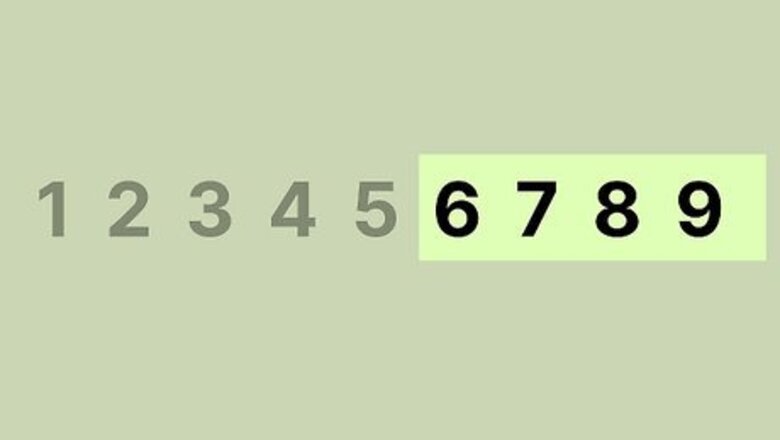
views
Using Vedic Math for Single-Digit Numbers
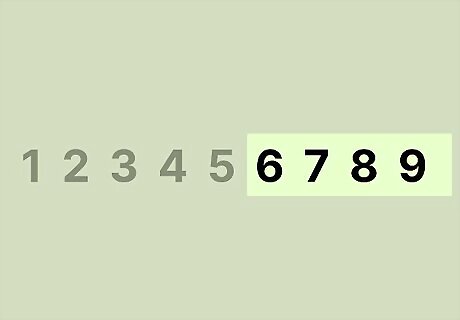
Use Vedic Math to multiply numbers higher than 5. If either of the numbers that you are multiplying are over 5, using Vedic Math can help you solve the multiplication equation more quickly and easily. If either number is below 6, however, it’s likely that it would be faster for you to simply recall the answer from memory. Vedic Math multiplication is designed for larger sums of numbers. Therefore, when multiplying by 1, 2, 3, 4, or 5, it’s usually much quicker and simpler to solve the equation without using Vedic Math.
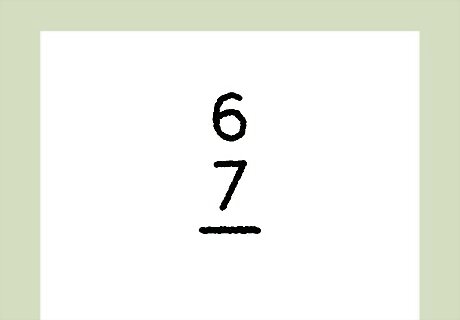
Write down the numbers you wish to multiply. On a piece of paper, write the first number of the equation on top and the second number directly below it. Draw an equation line below the second number (you will write down the solution to the problem below this line later). For example, if you’re using Vedic Math to multiply 6 x 7, write 6 on a piece of paper, then write 7 right below it. Draw the equation line just below the 7. While Vedic Math is characterized as a form of mental calculation to be used without a pen and paper, it can be useful for those starting out to write it out in order to better visualize the steps. If you are more adept at solving math problems in your mind, however, you can simply visualize this layout rather than writing it down.
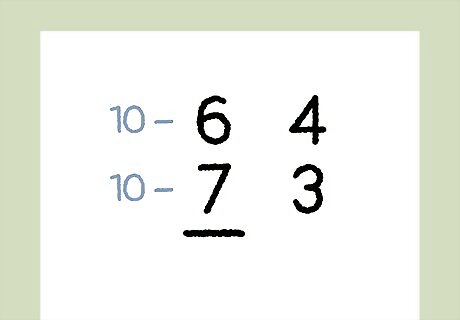
Subtract both the top and bottom numbers from the Vedic base of 10. Performing the calculations one at a time, first subtract the top number from 10 and write the result to the right of the original number. Then, subtract the bottom number from 10 and write it to the right of the original number and just below the new calculation for the top number. You should now have 2 columns of numbers, with your original numbers in a column on the left and your new numbers in a column to the right. For example, for multiplying 6 x 7, first perform 10 – 6, which equals 4. Write the 4 to the right of the 6. Then, perform 10 – 7, which equals 3. Write the 3 to the right of the 7, just below the 4. By subtracting from 10, you’re taking the ‘base’ of the numbers. The term ‘base’ in Vedic Math refers to the base 10 number system used in Vedic Math, as well as the fact that the ‘base’ number will be used as the basis for calculation. The standard bases in Vedic Math are 10, 100, 1000, and 100,000. For single-digit numbers, you’ll use the base of 10 because it’s the base closest to single-digit numbers.
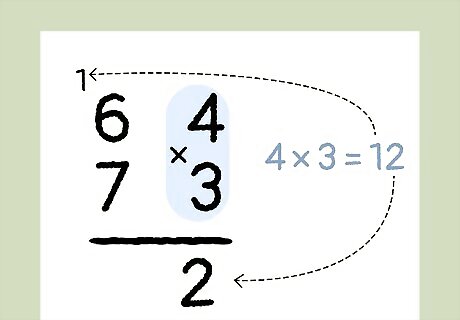
Multiply the numbers in the column on the right. Using traditional multiplication, multiply the top number in the column on the right by the bottom number in the column on the right. If the answer to the multiplication is greater than 10, write the right-most digit below the equation line and carry the left-most digit to the next step. If the answer is a single-digit, simply write the single-digit answer below the equation line under the right column. For example, for the original equation 6 x 7, you now have 4 and 3 in the right column. Multiply 4 x 3, which equals 12. Write the 2, the right-most digit, below the equation line. Carry the 1, the left-most digit, to the next step. To help you remember the left-most number, you can write it off to the side. Be sure to write it away from the equation, though, so you don’t get confused.
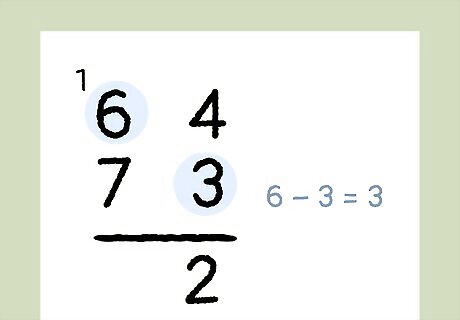
Subtract a right column number from the diagonal left column number. Choose either the top or bottom number from the left column (it doesn’t matter which one you choose – the solution will always turn out the same regardless). Then, subtract the number in the right column that is diagonal to it. For example, if the original equation is 6 x 7, 6 will be written on top of 7 in the left column, and 4 will be written on top of 3 in the right column. Therefore, you can either perform 6 – 3 or 7 – 4, both of which equal 3.
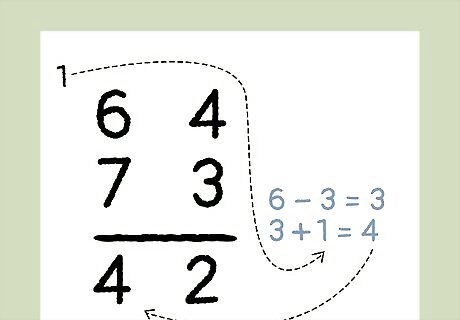
Add the number carried over (if applicable) to the result. If the solution to the multiplication of the numbers in the right column was over 10, you wrote down the right-most digit below the right column equation line and carried over the left-most digit. At this point, add the carried over digit to the solution of the diagonal subtraction in the previous step, and write down the total below the left column equation line. For example, for the original equation 6 x 7, 6 was written on top of 7 in the left column, and 4 was written on top of 3 in the right column. You then multiplied 4 x 3, which equals 12, and wrote the 2, the right-most digit, below the right column equation line and carried the 1, the left-most digit. At this point, you will then add the carried over 1 to the 3 that resulted from either 6 – 3 or 7 – 4 in the previous step, which equals 4. Write the 4 in the left column below the equation line.
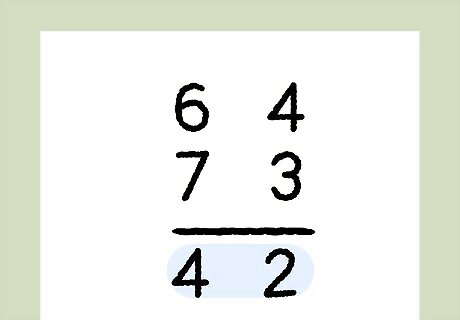
Read below the equation line to answer the original equation. You now have 2 numbers written below the equation line. Taken together, these numbers represent a single number, which is the solution to your original equation. For the example of 6 x 7, you now have a 4 in the left column and a 2 in the right column below the equation line. The answer to your original problem, 6 x 7, then, is 42.
Multiplying Double-Digit Numbers

Write down your multiplication equation. On a piece of paper, write the first double-digit number of the equation on top and the second number directly below it. Draw an equation line below the second number (you will write down the solution to the problem below this line later). For example, if you’re using Vedic Math to multiply 20 x 21, write 20 on a piece of paper, then write 21 right below it. Draw the equation line just below the 21. If you’re particularly adept at solving math problems in your mind, you can visualize this layout rather than writing it down. It can be helpful, though, to write out the equations when you are first starting out with Vedic multiplication.
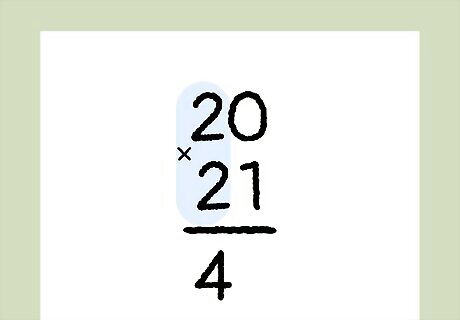
Use traditional multiplication to multiply the numbers in the left column. First, multiply the top left digit of the first number by the bottom left digit of the second number. Write your answer below the equation line, in the left-most column. This number is the first part of the solution. For example, when multiplying 20 x 21, first multiply the 2 (the first, left-side digit in 20) by 2 (the first, left-side digit in 21), which equals 4. Write the 4 below the equation line in the left column.

Multiply the diagonal digits and add the solutions. First, multiply the top left column digit with the bottom right column digit. Then, multiply the bottom left column digit with the top right column digit. Add the solutions together and write the answer below the equation line to the right of the solution in the previous step. For example, when multiplying 20 x 21, first multiply the 2 (the top left column digit in the 20) by 1 (the bottom right column digit in 21), which equals 2. Then, multiply 2 (the bottom left column digit in the 21) with 0 (the top right column digit in the 20), which equals 0. Add the solutions, which are 2 and 0, together, which equals 2. Write the 2 below the equation line to the right of the 4 that you’ve already written below the equation line.
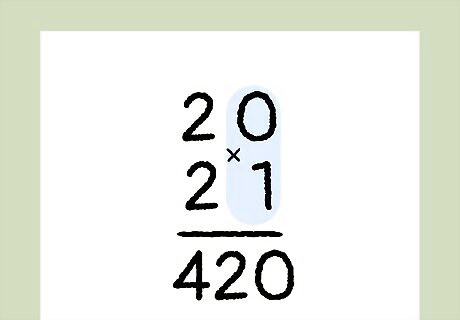
Find the final answer by multiplying the digits in the right column. Multiply the top digit in the right column by the digit at the bottom of the right column. Write the solution below the equation line in the right-most column. Then, read the number below the equation line left to right to get your final answer to the original equation. For example, when multiplying 20 x 21, multiply 0 (the top digit in the right column) by 1 (the bottom digit in the right column), which equals 0. Write 0 below the equation line to the right of the 4 and the 2 that you already have written down. Then, you can see that the answer to your original equation, 20 x 21, is 420.
Trying Vedic Math for Triple-Digit Numbers
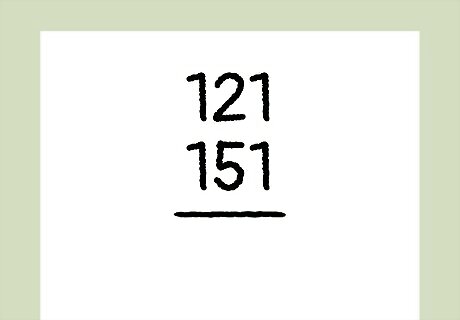
Write the numbers you’re multiplying on a piece of paper. First, write down the first three-digit number of the equation on top. Then, write the second number directly below it. Draw an equation line below the second number (you will write down the solution to the problem below this line later). You should have 3 columns of numbers. If you’re using Vedic Math to multiply 121 x 151, for example, write 121 on a piece of paper, then write 151 right below it. Draw the equation line just below the 151. While you’ll likely be able to perform Vedic multiplication in your head after some practice, it can be helpful to write out the equations when you’re first starting out.
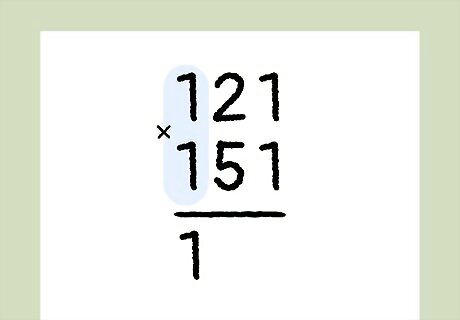
Multiply the numbers in the left column. First, multiply the top left digit of the first number by the bottom left digit of the second number. Write your answer below the equation line, in the left-most column. This number is the first part of the solution. For example, when multiplying 121 x 151, first multiply the 1 (the first, left-side digit in 121) by 1 (the first, left-side digit in 151), which equals 1. Write the 1 below the equation line in the left column.
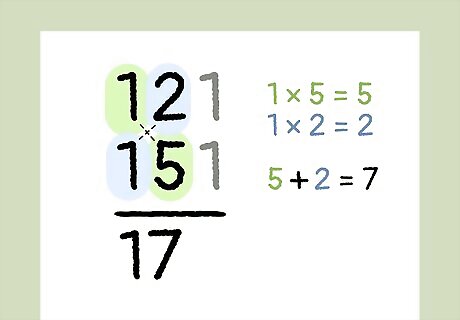
Multiply the left column digits with the diagonal middle digits. First, multiply the top number of the left column by the bottom number of the middle column. Then, multiply the bottom number of the left column by the top number of the middle column. Add the result of these two calculations together. The resulting number is the second part of the solution. For example, when multiplying 121 x 151, first multiply the 1 (the top left column digit in the 121) by 5 (the bottom middle column digit in 151), which equals 5. Then, multiply 1 (the bottom left column digit in the 151) with 2 (the top middle digit in the 121), which equals 2. Add the solutions, which are 5 and 2, together, which equals 7. Write the 7 below the equation line to the right of the 1 that you’ve already written below the equation line.
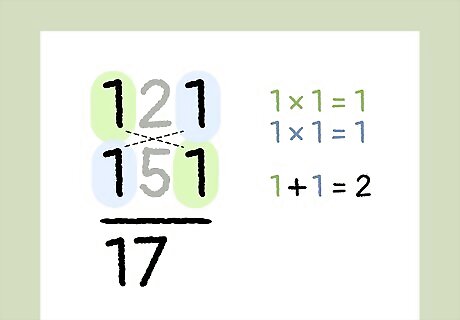
Multiply the left-most and right-most digits. First, multiply the top left-most digit with the bottom right-most digit. Then, multiply the bottom left-most digit by the top right-most digit. Add these two solutions together and write the answer off to the side to help you remember it. For example, when multiplying 121 x 151, multiply 1 (the top left-most digit) with 1 (the bottom right-most digit), which equals 1. Then, multiply 1 (the bottom left-most digit) with 1 (the top right-most digit), which equals 1. Add these solutions together, which equals 2.
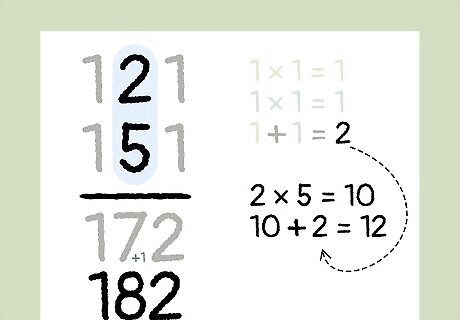
Add the multiplication of the middle digits to the previous solution. Multiply the top number of the middle column by the bottom number of the middle column. Then, add the solution to the number you found in the previous step. If the answer is less than 10, simply write down the answer below the equation line to the right of numbers you’ve already written down. If the answer is greater than 9, write the right-most digit below the equation line and add the left-more digit to the number to its left. For example, when multiplying 121 x 151, multiply 2 (the middle digit of 121) with 5 (the middle digit of 151), which equals 10. Add this 10 to the 2 you found in the previous step, which equals 12. Since 12 is greater than 9, write the 2 (the right-most digit in 12) in the third spot below the equation line to the right of the 1 and 7 you’ve already written down. Then, add the 1 (the left-most digit in 12) to the 7 (the digit to the left below the equation line. Therefore, at this point, you have 1, 8, and 2 written below the equation line.
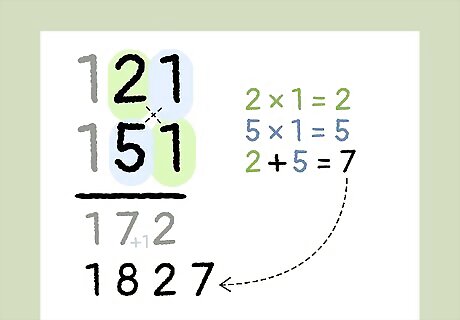
Go to the middle column to multiply the diagonals in the right column. First, multiply the top number of the middle column by the bottom number of the right column. Then, multiply the top number of the right column by the bottom number of the middle column. Add these numbers together and write the solution to the right of the 3 numbers you’ve already written down. For example, when multiplying 121 x 151, multiply 2 (the middle digit of 121) with 1 (the bottom right digit of 151), which equals 2. Then, multiply 1 (the top right digit of 121) with 5 (the middle digit of 151), which equals 5. Add these together, which equals 7. Write the 7 next to the 1, 8, and 2 you’ve already written down.
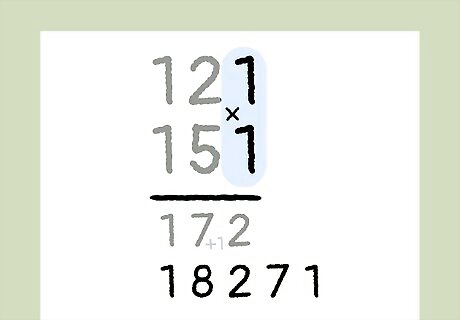
Multiply the numbers in the right column to find the solution. Multiply the top number in the right column by the bottom number in the right column. Write down the solution below the equation line to the right of the 4 numbers you’ve already written down. When you read from left to right then, you have the solution to the original equation. For example, when multiplying 121 x 151, multiply 1 (the right-most digit of 121) with 1 (the right-most digit of 151), which equals 1. Write the 1 to the right of the 1, 8, 2, and 7 you’ve already written down. Therefore, the answer to your original equation of 121 x 151 is 18,271.












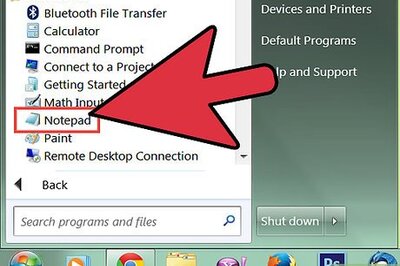


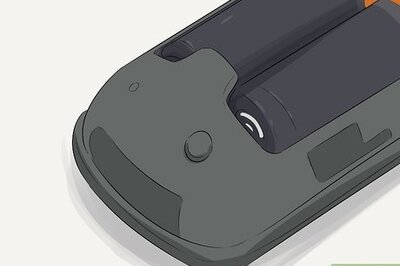



Comments
0 comment